The best cheap camera for 2024: finest budget cameras you can buy
The best cheap camera available for every budget

1. The list in brief
2. Best overall
3. Best mirrorless
4. Best travel
5. Best second-hand
6. Best instant
7. Best full-frame
8. Best action cam
9. Best tough
10. Best compact
11. Best vlogging
12. Best bridge camera
13. How to choose
14. How we test
The best cheap cameras prove you don't need a huge budget to take great photos. From entry-level DSLRs to affordable mirrorless models, we've extensively tested all of the best cheap cameras. You'll find our favorites ranked in the expert guide below.
Based on the results of our reviews, we think the best cheap camera for most people right now is the Nikon D3500. It's not longer in production, but you can still find the novice-friendly DSLR available online. That's a good thing, because its capable 24.4MP sensor and massive battery life make it one of the best beginner cameras you can buy.
If you'd prefer to buy a cheap mirrorless camera, we highly recommend the Fujifilm X-T200. We think it represents excellent value, combining 4K video skills, solid stills performance and a useful articulating touchscreen in a conveniently compact retro body.
Whatever you're looking for, we've put together this list to help you find the best cheap camera for your specific needs. Each entry has been tested exhaustively in the real world to ensure it meets our objective standards. Our experienced team checks everything from handling and battery life to image quality and ease of use. We've also shared some helpful buying tips below to make your decision easier.

Tim is TechRadar's Cameras editor, with over 15 years in the photo video industry and most of those in the world of tech journalism, Tim has developed a deeply technical knowledge and practical experience with all things camera related. Tim notes, "affordability depends on your budget. All of the cameras in this list have been selected because they offer fantastic value for money. Some are objectively cheap, while others represent the best bang for buck in their category."
The quick list
Use the summary below for a shortcut to the best cheap camera for your budget. When you find a cheap camera that ticks the right boxes, you can jump to our full write-ups using the links beneath each entry.
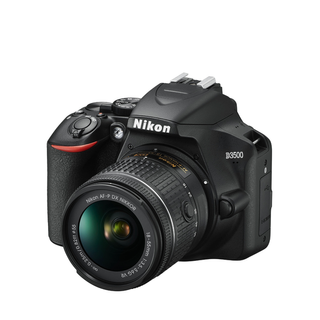
The best for most people
An entry-level DSLR for the mirrorless age, the Nikon D3500 tops our list with its easy handling, huge battery life and capable APS-C sensor.

The best cheap mirrorless
A real retro stunner, the Fujifilm X-T200 wraps smart features in nostalgic packaging to create a brilliant mirrorless option for new photographers.
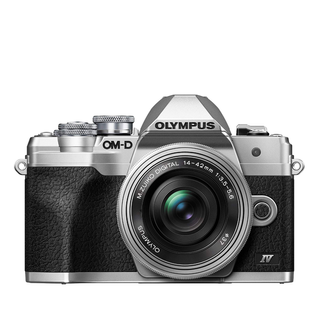
The best cheap travel camera
With a capable Four Thirds sensor and useful in-body image stabilization, the Mark IV is a small, versatile stills camera for travel photography.
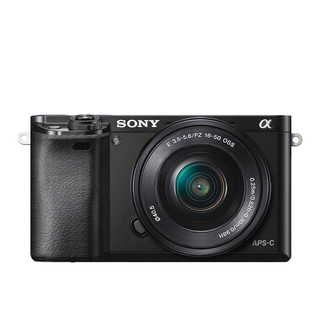
The best second-hand camera
Still available second-hand, the Sony A6000 costs the same as today’s entry-level models but rocks a powerful skill set that still holds up well.

The best cheap instant camera
A fun, no-frills camera that’s perfect for party snaps, the Fujifilm Instax Mini 12 makes instant photography simple and affordable for anyone to try.
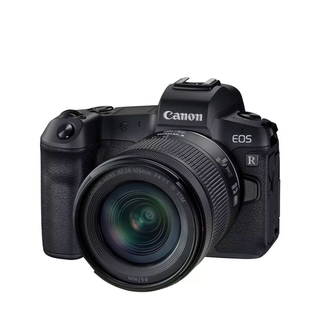
The best cheap full-frame camera
The Canon EOS RP isn’t without compromise, but its compact build and affordable price make it a great value option for those looking to shoot full-frame.
Load the next 5 products...
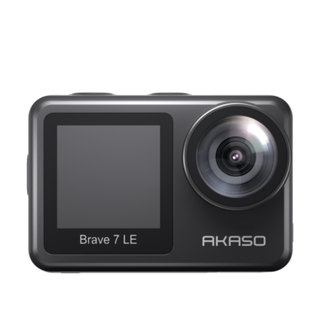
The best cheap action camera
With a generous feature set, including a front display that’s perfect for vloggers, the Akaso Brave 7 LE is an action camera that outperforms its price.
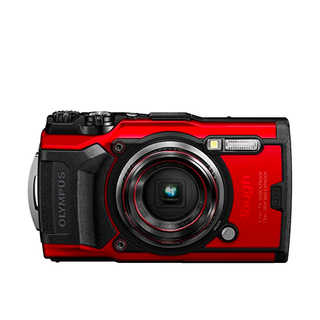
The best cheap tough camera
One of the best tough cameras you can buy, the Olympus Tough TG-6 is easy to use and offers outstanding value for adventurous photographers.

The best cheap compact camera
It’s not the latest model, but a compact build and capable 1-inch sensor mean the TZ100 is still a top choice for budget travel photography.
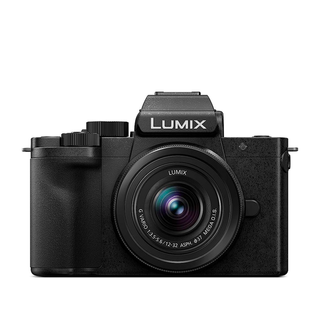
The best cheap vlogging camera
The Panasonic G100 is a portable Micro Four Thirds camera with a host of useful video features. Its three-mic audio setup makes it a win for vloggers.
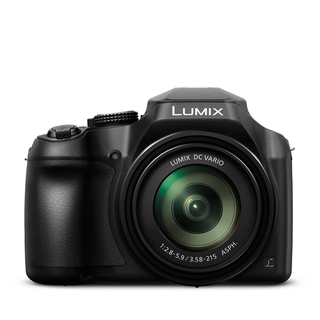
The best cheap bridge camera
If zoom length is your priority, the Lumix FZ80 / FZ82 is the best cheap bridge camera, with decent image quality and a versatile range of 20-1200mm.
The best cheap cameras in 2024
Why you can trust TechRadar
Below you'll find summary reviews for each of the best cheap cameras in our list. We've tested all of them extensively, so you know that you can trust our expert recommendations.
The best cheap camera overall
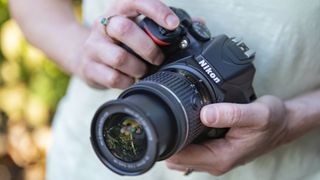
Specifications
Reasons to buy
Reasons to avoid
✅ You like a traditional DSLR: With great handling and excellent battery life, the Nikon D3500 offers learners all the classic strengths of a DSLR.
✅ You want lots of lenses: Nikon’s DX system has a huge range of lenses to suit almost every budget and style of photography.
❌ You want to shoot 4K video: The Nikon D3500’s 24.2MP sensor produces excellent stills, but its video resolution is limited to Full HD.
❌ You want a touchscreen: The D3500 is easy to use, but doesn’t feature the touchscreen interface found on many contemporary rivals.
DSLRs may be less and less common nowadays, but they still offer excellent value compared to mirrorless cameras. The Nikon D3400 was a hugely successful and popular DSLR, and the Nikon D3500 has taken its baton into the mirrorless age, making it the best budget camera for new photographers. Key changes include an improved APS-C sensor and a longer battery life of 1,550 frames per charge.
While it's also worth considering the mirrorless alternatives in our guide, the D3500 is the most user-friendly option in this list – particularly if you want to use it with longer lenses. In our tests, we found that its 24MP sensor delivered high-quality images. It also proved super-easy to handle, thanks to a better grip and slightly lighter body than the D3400. From our review, we think this is a DSLR that really nails the basics, making it easy and affordable for novices to upgrade their photography.
Read our in-depth Nikon D3500 review
The best cheap mirrorless camera

Specifications
Reasons to buy
Reasons to avoid
✅ You like retro styling: Among entry-level cameras, the X-T200 is easily one of the most stylish, with a retro DSLR design that stands out.
✅ You want an electronic viewfinder: The eye sensor isn’t completely reliable, but the 2.36 million-dot viewfinder is useful for framing.
❌ You shoot continuous action: 8fps burst shooting speeds are decent, but the limited buffer depth means the rate slows quickly.
❌ You find a good deal on the X-T30: The X-T200 offers excellent value, but Fujifilm’s superior X-T300 can often be found for not much more.
We're still fans of the Fujifilm X-T30, but this cheaper, learner-friendly version of that camera is our favorite mirrorless option for those looking for an affordably entry point into photography or film-making. It's a big improvement over its X-T100 predecessor in almost every way, including the hybrid autofocus system. Unlike the Fujifilm X-A7, you also get a viewfinder for framing shots, which is especially good news in bright light while traveling.
We discovered in our review that image quality was reliably lovely, producing excellent color and dynamic range. We also loved the lightweight, retro design and fantastic 3.5-inch rear touchscreen. The only downside we found from our tests is that subject-tracking can be a little hit-and-miss during burst shooting and isn't available for video. Otherwise, we think this is one of the best cheap cameras around for those who want a new mirrorless model.
Read our in-depth Fujifilm X-T200 review
The best cheap travel camera
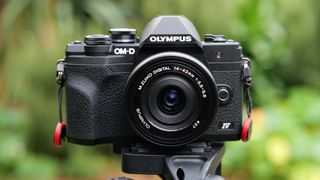
Specifications
Reasons to buy
Reasons to avoid
✅ You want a small, powerful stills camera: Compact proportions belie the class-leading stills capabilities of the E-M10 Mark IV.
✅ You often shoot handheld: In-body image stabilization gives the Mark IV an edge over rivals, keeping handheld shots sharp.
❌ You record a lot of video: The E-M10 Mark IV can shoot decent footage, but no mic input and a 4K/30p cap limit its blogging potential.
❌ You own the E-M10 Mark III: Upgrades include a new sensor and flip-down screen, but these don’t justify swapping from the Mark III.
If you’re an eager photographer in the market for a compact mirrorless camera, the Olympus OM-D E-M10 Mark IV should be top of your list. An affordable Micro Four Thirds model, it pairs a capable 20.3MP sensor with impressive in-body image stabilization to deliver consistently attractive images. An ergonomic grip, approachable button layout, and handy flip-down touchscreen make the Mark IV an accessible upgrade for smartphone users. A wide catalog of lenses also give it extra versatility beyond the kit lens.
With footage capped at 4K/30p and no microphone or headphone input, video isn’t a major focus. Instead, this is a small, powerful camera for stills: we discovered in our review that dynamic range is better than anything a smartphone can capture, while the IBIS system keeps images sharp even when shooting handheld. We did find that AF tracking across the Mark IV’s 121 points can be a little patchy, but improved face detection and subject tracking from the Mark III mean it’s largely reliable. Our tip is to stick to centre point focus and you’ll find it fast, even in low light.
Read our in-depth Olympus OM-D E-M10 Mark IV review
The best second-hand camera
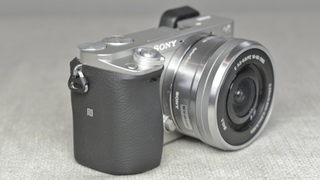
Specifications
Reasons to buy
Reasons to avoid
✅ You want a small system camera: Excellent image quality and a useful viewfinder make the A6000 a fantastic small package.
✅ You like personalized controls: All of the buttons and function menus can be customized to give you quick access to your regular settings.
❌ You want a touchscreen interface: The A6000’s display isn’t touch-sensitive and there’s no quick way to set the AF point.
❌ You want an articulating screen: The screen on the A6000 tilts but doesn’t fully articulate, so it’s not as useful for vlogging.
Don’t let the price fool you: the A6000 costs the same as other entry-level DSLR and mirrorless cameras, but it’s an advanced and powerful camera that has only dropped to this price by being on the market since 2014. It may be old, but most of the specifications still look surprisingly fresh today. This includes a 24MP APS-C sensor, a fast hybrid 179-point autofocus system, and continuous shooting at 11 frames per second (fps).
We found during our review that it delivered fantastic image quality, even if its age shows in other areas. It only shoots 1080p Full HD video, and the screen isn’t touch-sensitive – which we found to be a little frustrating for setting AF points. Still, the latter is still the case on many Sony cameras and the A6000’s high-end features ensure that it's a camera that will grow with you.
Read our in-depth Sony Alpha A6000 review
The best cheap instant camera

Specifications
Reasons to buy
Reasons to avoid
✅ You want point-and-shoot simplicity: Auto exposure control and affordable film refills make the Instax Mini 12 an accessible camera to shoot with.
✅ You want vibrant party prints: With rich vintage colors, Instax prints have a distinctively attractive look that’s great for capturing memories.
❌ You shoot in sunlight a lot: The Mini 12 tends to overexpose images in bright light, not helped by the always-on flash which fires every time.
❌ You want a tactile camera: The bubble-like design is fun, but it’s also slippery in the hand making it tricky to keep hold of at times.
Our favorite instant camera is also one of the top cheap cameras for those who want the no-frills fun of instant photography. Simple and affordable, we found in testing that the Fujifilm Instax Mini 12 builds on everything that the Instax Mini 11 did well, making it easy to create punchy party snaps. While prints can seem a little small, the Mini 12 makes it straightforward for first-time users to capture rich, attractive images at a reasonable price.
Though its design proved a little slippery during our review, we think the Mini 12 is otherwise a comfortable camera for anyone to use. It now turns on with a twist of the lens, which we think is more intuitive than previous editions. You still get the option of close-up mode by pulling the lens out, while parallax correction means the viewfinder more accurately represents how scenes will be printed. From our tests, the Mini 12 continues to overexpose images in bright sunlight, although repositioned sensors mean your fingers are less likely to interfere with light readings.
Read our in-depth Fujifilm Instax Mini 12 review
The best cheap full-frame camera
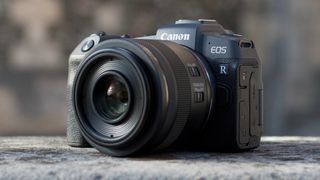
Specifications
Reasons to buy
Reasons to avoid
✅ You want full-frame on a budget: Offering a capable feature set at a reasonable price, the EOS RP is a fantastic full-frame entry point.
✅ You want a great value camera: With a light, compact build, solid image quality and stellar AF performance, the EOS RP is a great package.
❌ You like a lot of lens options: There are limited native lenses for the RF mount, and even fewer that make sense on the RP’s small body.
❌ You shoot a lot of video: It can shoot detailed footage, but rolling shutter and cropped 4K limit the video capabilities of the EOS RP.
Reasonably priced for a full-frame mirrorless camera, the Canon EOS RP is a compelling option if you want to shoot with a large sensor. Built around the same RF mount as the EOS R, its native lens line-up is limited, but a bundled adapter at least allows you to use existing EF glass.
Despite housing a 26.2MP full-frame sensor, our tests found the EOS RP to be remarkably compact yet reassuringly well-made. Button placement will irk some, but we found both the physical controls and touchscreen to be responsive. With Canon’s Digic 8 processor driving performance, autofocus proved fast and reliable in our review. Burst rates drop to 4fps with continuous focus, but the AF generally did a solid job of locking on. We also found the buffer to be more generous than expected.
The Canon EOS RP isn’t without compromise. Besides a lack of sensor-based image stabilization, battery life was underwhelming in testing, while the metering system seemed slightly sensitive. Rolling shutter and a 4K crop also limit its video skills. But if you want full-frame mirrorless shooting on a limited budget, it’s hard to argue with the Canon EOS RP’s core performance.
Read our in-depth Canon EOS RP review
The best cheap action camera

7. Akaso Brave 7 LE
Specifications
Reasons to buy
Reasons to avoid
✅ You want a cheap action camera: A feature-packed 4K camera with two screens, the Akaso Brave 7 LE represents excellent value.
✅ You want reliable build quality: Despite its affordable price, the Akaso Brave 7 LE is a well-built action camera with weather sealing.
❌ You want the best stabilization: The Akaso’s electronic image stabilization can be jumpy, and doesn’t match up to a GoPro’s abilities.
❌ You want the sharpest 4K footage: 4K video from the Akaso Brave 7 LE is good, but can appear slightly soft compared to rivals.
If you need a cheap action camera, then the Brave 7 LE should certainly make your shortlist. Considering its price tag, it's packed with features including weather-sealing and a front-facing screen that's handy for vloggers. We also found that this action cam's audio was better than any other action cam outside of GoPro, in quieter environments at least.
The Brave 7 LE also has an intuitive touchscreen interface, which is another feature that tends to be overlooked by budget action cams. Downsides? While the video quality is decent at 4K resolution, its slightly soft look doesn't quite match the rest of the action cam's features. The image stabilization also falls short of GoPro standards. But for the price, it's still one of the best all-round action cams you can buy.
The best cheap tough camera
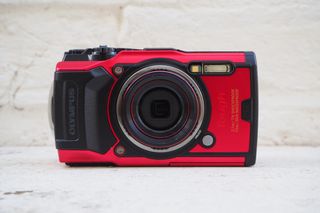
Specifications
Reasons to buy
Reasons to avoid
✅ You want an intuitive rugged camera: Super tough yet easy to operate, the TG-6 is an ideal choice for adventurous novices.
✅ You’d like a compact camera: The Tough TG-6 is conveniently pocketable, yet an internally stacked zoom lens keeps it versatile.
❌ You need the best image quality: Image quality is fair, but the small sensor means stills aren’t outstanding.
❌ You mainly shoot in bright conditions: Both image quality and display visibility suffer in outdoor conditions.
Breaking your camera is one way to make photography an expensive hobby. Investing in a rugged model should cut replacement costs – and the Olympus Tough TG-6 is one of the best tough cameras you can buy. Freeze-proof, shockproof and waterproof: its reassuringly industrial shell is robust enough to survive all manner of extreme scenarios. It’s also an intuitive camera to use: in testing, we found its arge buttons made operation accessible, while an improved 3-inch LCD display ensured good visibility in bright conditions.
Focusing proved snappy during our review, while an equivalent zoom range of 25-100mm adds welcome versatility, even if a little detail is lost at the telephoto end. Our tests revealed that image quality is decent enough for a 1/2.3-inch sensor, with rich colors – although the TG-6 is prone to overexposure. The older TG-5 is similarly equipped and less expensive, but the TG-6 represents excellent value for adventurous photographers thanks to its significantly sharper screen.
Read our in-depth Olympus Tough TG-6 review
The best cheap compact camera

Specifications
Reasons to buy
Reasons to avoid
✅ You want a compact travel camera: Pocket-friendly yet equipped with 1-inch sensor and 10x optical zoom, the TZ100 is built for travel.
✅ You value good controls: With plenty of buttons and dials, plus a responsive touchscreen, the TZ100 is an enjoyable camera to use.
❌ You like an articulating display: Unlike many rivals, the Panasonic TZ100 has a fixed display which limits framing flexibility.
❌ You want ergonomic handling: The TZ100 is nice to operate, but its small proportions mean the hand grip isn’t the biggest.
Back in 2017, we called the Panasonic TZ100 “the perfect compact camera.” Although several models have since arrived with superior specs, the TZ100 remains a fantastic option for those looking for an affordable travel camera. Its metal shell is solid yet small enough to slip into a pocket. The main controls are clustered on the back for easy one-handed control, while function buttons offer the welcome option of customization. The touchscreen is responsive, too.
On the go, we discovered that the TZ100’s 1-inch sensor delivers vibrant, punchy images with a fair level of detail for an older compact, even in low light. Dynamic range is also decent and noise isn’t generally an issue. The 10x optical zoom will be versatile enough for most, while the option of shooting 4K footage makes simple vlogs an option as well. It's not quite as powerful as today’s premium compacts, but the TZ100 is plenty good enough for taking travel snaps to share online and will still surpass most smartphones.
Read our in-depth Panasonic Lumix ZS100 / TZ100 review
The best cheap vlogging camera

Specifications
Reasons to buy
Reasons to avoid
✅ You want a versatile vlogging tool: With plenty of video-focused features, including three mics, the G100 is a great choice for vloggers.
✅ You need something lightweight: Built small but powerful, the G100 is a neatly sized smartphone alternative for shooting on the move.
❌ You shoot a lot in low light: The Panasonic G100 does well in a lot of scenarios, but its small sensor struggles with a loss of detail after dark.
❌ You value direct access controls: Its smaller body is convenient, but also means the G100 doesn’t have space for many physical controls.
With a compact design and solid feature set, we think the G100 is an excellent choice for vloggers and YouTubers without a big budget. We found its small size and weight convenient in testing, making the G100 an easy camera to travel with, even if that means sacrificing the direct access controls found on larger alternatives. The G100 also benefits from a wide array of compatible Micro Four Thirds lenses, offering useful versatility.
We were impressed in our review with the video-focused features of the G100. The Nokia Ozo Audio system uses three microphones to automatically detect sound from different directions, and worked very effectively in testing. The quality of footage also proved good on the whole, with great colors and detail. We were disappointed with the loss of detail in low light, though, and the crop on 4K 30p video. If you mainly shoot stills, you’ll find better overall value from cameras like the Olympus OM-D E-M10 Mark IV. But if you’re looking for a small shooting tool with powerful video features, we think the G100 is a budget winner.
Read our in-depth Panasonic Lumix G100 review
The best cheap bridge camera
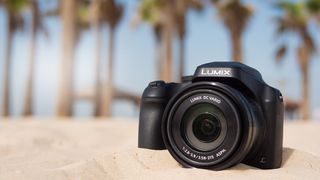
Specifications
Reasons to buy
Reasons to avoid
✅ You want an easy all-in-one option: Capable yet straightforward to use, the FZ80 / FZ82 is a great entry-level all-rounder.
✅ You need powerful optical zoom: With a huge 20-1200mm zoom range, this is very versatile option for use in a range of scenarios.
❌ You shoot regularly after dark: Noise at the highest ISO settings is high, which means this isn’t the best choice for low-light photography.
❌ You want the best EVF: The viewfinder lacks punch, while low magnification makes it feel as if the image is at the end of a tunnel.
Launched in 2017, the Panasonic Lumix FZ80 (also known as the Lumix FZ82 outside the US) is still one of the most affordable bridge cameras you can buy. It remains a solid choice if zoom reach is your priority: its lens goes from an ultra-wide 20mm all the way to the far reaches of 1200mm. During our review, it proved capable of producing decent image quality – as long as you're aware of its limitations.
We found it best to shoot no higher than ISO 800, or ISO 1600 in an emergency, so it's best to avoid low light. But in daylight conditions, it's still a very useful companion, particularly at this price – and we found that Panasonic's Power O.I.S. image stabilization kept things nice and stable at longer focal lengths. Sure, the viewfinder could be better, but this remains one of the best cheap bridge cameras around.
Read our in-depth Panasonic Lumix FZ80 / FZ82 review

How to choose the best cheap camera for you
How to choose
Buying a budget camera will usually mean accepting a few compromises. A cheaper DSLR might not capture 4K footage, for example, while a more affordable mirrorless model may lack a viewfinder or shoot at lower burst speeds than its costlier competitors. But whichever type of camera you decide to buy, you should consider what and how you like to shoot – and make sure that, at the very least, it ticks the key boxes for your specific needs.
So if you normally shoot stills, a cheap camera’s video skills are less important. Instead of focusing on whether it can capture 4K footage, look for something with a decent sensor and a relatively high resolution (20MP and above). Similarly, if you’re happy framing with an optical viewfinder and using buttons to navigate system menus, you don’t need to worry too much about whether a camera has a sharp touchscreen interface. But it is always worth making sure that a camera’s handling is comfortable and that its physical controls are useful and accessible.
If you’re shopping for an affordable travel camera, your focus should be battery life and zoom versatility. Don’t get too caught up in software tricks or raw shooting. Those are nice extras, but it’s much easier to edit JPEGs when you’re back home than it is to crop in on a faraway subject.
And if you’re planning to buy an interchangeable lens camera, be sure to consider the cost of lenses. A camera body might be cheap, but expensive glass will limit your ability to experiment with different barrels. Look for a camera with a popular lens mount (Micro Four Thirds, for example) to ensure you have maximum flexibility when it comes to buying new glass.
Which camera is best for a low budget?
The list above features a range of cameras to suit photographers with a limited budget. Which option is best for you will depend on what you’ll use your camera for and how versatile you’d like it to be.
One option is to consider entry-level models like the Nikon D3500. These are designed with new photographers in mind, so they usually feature simple, accessible controls that are easy to get to grips with. To keep costs down, entry-level cameras don’t usually include advanced features or performance, but they should nail the basics. That means solid battery life, great handling, and decent image quality.
You can also consider older mid-range mirrorless cameras. These won’t offer cutting-edge technology, but should still be very capable – especially if you’re upgrading from a smartphone. Previous generations tend to be discounted as newer versions arrive, which means models that are a few years old normally become more affordable. Take a look at the Sony A6000: its price now is a lot lower than when it launched in 2014, yet it still features a 24.3MP sensor, 11fps burst shooting and a capable 179-point autofocus system.
If you’re looking for a cheap travel camera, powerful compacts like the Panasonic TZ100 offer excellent value and versatility, with its 1-inch sensor and 10x optical zoom. Or if it’s an outright bargain you’re after, instant cameras are a cheap, accessible way to have fun with photography. Models like the Fujifilm Instax Mini 12 are easy and enjoyable to use, producing immediate prints that make shooting more tactile.
There’s also value to be found in lesser-known names. The Akaso Brave 7 LE, for example, is our favorite cheap action camera. The make might not be famous, but the camera is feature-packed and intuitive, making it the best budget action cam you can buy.
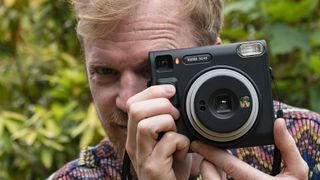
How we test cheap cameras
We test cheap cameras in the same way as models with higher price tags: thoroughly. While the value may play a more important role in our overall rankings, the cameras themselves still need to perform in the real world. Putting them through our usual test procedures lets us see which ones outperform their price tags, and which haven't dated so well.
To start with, we look at the camera's design, handling, and controls to get a feel for which kind of photographer it's most suitable for. We then take it out on a shoot, where we'll test its startup speed and use it both handheld and on a tripod.
To assess the camera's performance, we use a formatted SD card and shoot in both raw and JPEG (if available). For burst shooting tests, we dial in our regular test settings (1/250 sec, ISO 200, continuous AF) and shoot a series of frames in front of a stopwatch to see if it matches its official speeds. We'll also look at how quickly the buffers clears and repeat the test for both raw and JPEG files.
In various lighting conditions, we also test the camera's different autofocus modes (including Face and Eye AF) in single point, area, and continuous modes. We'll also shoot a mix of photos (portrait, low light, landscape, macro/close-up) in RAW and JPEG to get a feel for the camera's metering accuracy and its sensor's ability to handle noise and resolve fine detail.
Assuming the camera's RAW files are supported by Adobe Camera Raw, we'll also process some test images to see how far we can push areas like shadow recovery. We'll also test its ISO performance across the whole range to get a sense of the levels we'd be happy to push the camera to.
Battery life is tested over the course of a day with the screen set to the default brightness level. Once the battery has hit zero, we'll then count the number of shots to see how it compares to the camera's official CIPA rating. Finally, we test the camera's video skills by shooting some test footage at different frame rates and resolutions, along with its companion app.
We then take everything we've learned about the camera and factor in its price to get a sense of the value for money it offers, before reaching our final verdict.
Get daily insight, inspiration and deals in your inbox
Get the hottest deals available in your inbox plus news, reviews, opinion, analysis and more from the TechRadar team.

Tim is the Cameras editor at TechRadar. He has enjoyed more than 15 years in the photo video industry with most of those in the world of tech journalism. During his time as Deputy Technical Editor with Amateur Photographer, as a freelancer and consequently editor at Tech Radar, Tim has developed a deeply technical knowledge and practical experience with cameras, educating others through news, reviews and features. He’s also worked in video production for Studio 44 with clients including Canon, and volunteers his spare time to consult a non-profit, diverse stories team based in Nairobi. Tim is curious, a keen creative, avid footballer and runner, and moderate flat white drinker who has lived in Kenya and believes we have much to enjoy and learn from each other.
- Chris Rowlands
- Mark WilsonSenior news editor
